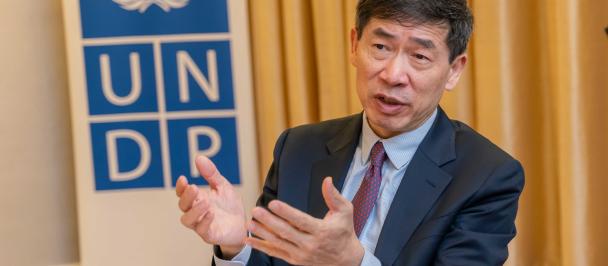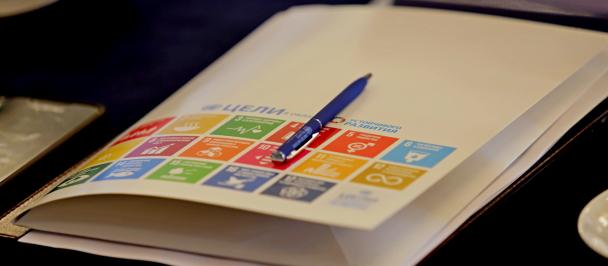SDG Push: A System Approach to Accelerate the SDGs in South Africa
May 24, 2023

By Rogers Dhliwayo and Ramos Emmanuel Mabugu
As the world faces a challenging period with increasing pressure on natural resources, gender inequality, and heightened risks for vulnerable populations, practical approaches to advance system transformation are more important than ever. The current economic climate presents challenges to achieving progress on the United Nations Sustainable Development Goals (SDGs). As featured in a session of the Integrated Policy Practitioners’ Network (IPPNs’) Knowledge Café series, SDG Push can help overcome these challenges while accelerating SDG progress.
The SDG Push framework is designed to help countries achieve stable footing by reimagining and recalibrating how they determine, interrogate and advance development interventions. It builds on lessons learned through the COVID-19 pandemic and the first half of the 2030 Agenda, to advance longer-term structural transformation while balancing short-term imperatives.
The SDG Push framework has several key elements, including scoping, acceleration dialogues, modelling, sustainable finance, and acceleration pathways. The scoping phase examines specific contexts and trends with data visualization via the SDG Push Diagnostic, establishing a rapid landscape of trends, current priorities, futures, and interlinkages.
Acceleration Dialogues leverage sensemaking protocols to explore scoping outcomes, interrogate previous policies and chart accelerators. Modelling engages new forms of participatory and economic modelling to assess the impact of potential accelerators.
Sustainable finance estimates the financing and feasibility of the potential accelerators, using SDG finance tools such as the Integration National Financing Framework (INFF). Acceleration Pathways integrate insights developed through this approach with data visualizations and recommendations to advance policy interventions.
Currently, Peru, Moldova, Indonesia, Namibia, and South Africa are piloting the SDG Push funded by Deutsche Gesellschaft für Internationale Zusammenarbeit (GIZ) and supported technically by UNDP. Let's take a closer look at how the process is unfolding in South Africa.
The promise of the SDG Push to South Africa is to identify accelerators and suggest possible partnerships for SDG acceleration that help address the triple development challenges of high inequality, poverty and unemployment. South Africa has finalized the second in a series of five steps of the SDG Push Diagnostic.
Building on the first step of developing an SDG Push Diagnostic Scoping Note, the dialogues with stakeholders from government, civil society, United Nations and Development Partners identified a set of potential strong accelerators (or points of intervention from within these broad areas) that could change the trajectory of development in South Africa.
The SDG Push Diagnostic Dialogue reaffirmed that ending poverty, and reducing inequality and unemployment are the main development challenges. While structural reforms including credible policies to align private sector growth strategies to global, national and local priorities, stimulating private sector investment and employment and skills matching interventions agenda remain the primary mechanism to revive growth, a range of complementary actions such as expanding social protection to reach those currently excluded are also needed in the short to medium-term.
The outcome of these dialogues is feeding into the third step of modelling which entails constructing and using a dynamic Computable General Equilibrium and a Micro-Simulation modelling of South Africa’s current development trajectory. A Business as Usual (BAU) or reference scenario to 2030 is constructed and compared with the following alternative scenarios: skill formation acceleration[1], services sector growth acceleration,[2] industry sector growth acceleration[3], expanding social protection to the bottom 40% of the population complemented by active labour market policies to help workers upskill and re-skill to keep or change their job[4], adapt to the green and digital transitions, and find other ways out of poverty.
Each of these scenarios simulates an ambitious yet achievable effort to improve economic and social outcomes beyond what is projected in the BAU scenario. A main value-add of this economywide modelling approach is that it allows analysis of trade-offs and permits a comparison of the most effective ways to finance alternative interventions. The latter is especially relevant as South Africa, like other developing countries, is currently grappling with challenges posed by limited fiscal space. The identified portfolio of accelerators will be costed to provide possible financing mechanisms given the country's limited fiscal space. The SDG Push will provide policy learning and build capacity in the country to identify key interventions that have systematic effects across the SDGs.
Considering that the SDG Push framework provides a practical and innovative approach to accelerate progress towards the SDGs even in challenging times, by identifying potential accelerators and integrating insights from stakeholders, the SDG Push can help South Africa to create a more sustainable and equitable future.
[1] Doubling of the supply of tertiary education, i.e., from an annual increase of 2.2% under the BaU scenario to 4.4%.
[2] This is to address the demand for skills generated, that is, to absorb the additional supply of labour with tertiary education, with the employment rate of tertiary education identical at the beginning and end of the period.
[3] Industry sector growth acceleration to generate identical economywide average growth rate over 2023-2030 as in the ‘services sector acceleration scenario’.
[4] This simulation uses a slight variant of the model which is a microsimulation-macroeconomic variant that starts from poverty analysis and then feeds the results of this analysis to the macroeconomic model and then back to the microsimulation model.

 Locations
Locations

